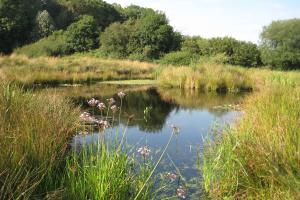At Chris Rabone Landscapes we pride ourselves in high quality design and an eye for detail.
We are launching monthly feature articles on a range of design elements to include advise and inspiration for your garden. Design articles will include paving, walling and steps, garden furniture, rockeries and timber structures.
We are pleased to launch this months feature article on water features:
Water features
This article on water features covers
Article 1-natural ponds and water features,
Article 2-ponds and rockeries,
Article 3-wiers waterfalls and streams
Article 4-small ornamental water features.
Natural ponds and wildlife habitats-Create a natural effect and enhance the environment.
An informal or natural looking water feature often attempts to emulate nature by fusing with the surrounding setting. A completely natural looking pond, or a wildlife pond, surrounded by wildlife planting can be achieved for a small or large pond. The process is described below in the large scale pond that we constructed near Broughton in Furness.
Alternatively you may want to integrate the pond more closely into the garden design opting for a “naturalistic’ rather than a ‘natural’ look. The main differences between the totally natural and the naturalistic pond are in the marginal planting and the edge treatment.
Construction methods for creating a natural pond
Unlined ponds
Unlined pond-Tapping into an existing water table and collecting storm water run off. This method is used where there is an existing boggy area of ground where water naturally collects and there is a relatively high water table. Refer to our case study on the next issue 'Creating a large natural pond'
Dew Ponds using puddled clay-This is a traditional method of lining a pond. 20 to 30 cm of clay is used to line the base of the pond and is fully compacted using a specialist plate vibrator or whacker plate. This is a traditional method and is only suitable in certain environments where the water level of the pond will not drop significantly through evaporation as the clay can dry out causing cracks and leaks. Clay lined ponds can be reinstated by compacting the clay again.
Lined ponds
Waterproof liner- The pond is dug to shape with gently sloping sides all round, lined to make it waterproof, and the base and the sides are overlaid with good topsoil and a layer of gravel if required. Depending on the terrain underneath the pond, it is advisable to put sand under the liner and sandwich the liner with 2 layers of geotextile underlay. This helps to avoid any damage and puncturing of the liner. We will discuss liner and underlays later in the article.
Reservoir-damming an existing stream. An existing water source such as a stream or a spring can be tapped into. Refer to the case study in the next issue 'damming an existing stream'


